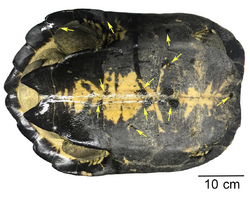Biology:Yellow-headed temple turtle
| Yellow-headed temple turtle | |
|---|---|

| |
| Scientific classification | |
| Domain: | Eukaryota |
| Kingdom: | Animalia |
| Phylum: | Chordata |
| Class: | Reptilia |
| Order: | Testudines |
| Suborder: | Cryptodira |
| Superfamily: | Testudinoidea |
| Family: | Geoemydidae |
| Genus: | Heosemys |
| Species: | H. annandalii
|
| Binomial name | |
| Heosemys annandalii (Boulenger, 1903)[3]
| |
| Synonyms[4] | |
| |
The yellow-headed temple turtle (Heosemys annandalii) is a large species of turtle in the family Geoemydidae. The species is native to Southeast Asia.
Etymology
The common name, "yellow-headed temple turtle", is derived from the fact that it is often found near Buddhist temples within its range.[citation needed]
The specific name, annandalii, is in honor of Scottish herpetologist Nelson Annandale.[5]
Description
H. annandalii may grow to over 20 in (51 cm) in straight carapace length.[citation needed]
Behavior
H. annandalii is aquatic, and is generally herbivorous.[citation needed]
Conservation status
The Convention on International Trade in Endangered Species of Wild Fauna and Flora (CITES) suspended trade of yellow-headed temple turtles in July 2012.[6]
Geographic range
H. annandalii is found in Cambodia, Laos, Malaysia, Thailand, Vietnam, and possibly Myanmar.[3][4]
Habitat
The preferred natural habitats of H. annandalii are wet forests and freshwater wetlands.[1]
Captivity
H. annandalii may live in captivity for up to 35 years.[citation needed]
Two turtles were hatched in November 2019 at the Columbus Zoo and Aquarium. Heosemys annadali has been breed in captivity.[7]
Parasites
The leech Placobdelloides siamensis is an ectoparasite of this turtle.[8]
References
- ↑ 1.0 1.1 Cota, M.; Horne, B.D.; McCormack, T.; Timmins, R.J. (2021). "Heosemys annandalii". IUCN Red List of Threatened Species 2021: e.T10041A495907. doi:10.2305/IUCN.UK.2021-1.RLTS.T10041A495907.en. https://www.iucnredlist.org/species/10041/495907. Retrieved 19 November 2021.
- ↑ "Appendices | CITES". https://cites.org/eng/app/appendices.php.
- ↑ 3.0 3.1 Rhodin 2011, p. 000.190
- ↑ 4.0 4.1 Fritz 2007, p. 224
- ↑ Beolens, Bo; Watkins, Michael; Grayson, Michael (2011). The Eponym Dictionary of Reptiles. Baltimore: Johns Hopkins University Press. xiii + 296 pp. ISBN:978-1-4214-0135-5. (Hieremys annandalii, p. 9).
- ↑ "Times-Tribune CITES 2012". http://thetimes-tribune.com/news/health-science/xxx-1.1349579.
- ↑ "Yellow-headed temple turtles hatch at the Turtle Conservation Centre in Cuc Phuong National Park, Vietnam". (10 April 2015). Asian Turtle Program. Archived from the original 8 January 2020.
- ↑ Chiangkul, Krittiya; Trivalairat, Poramad; Purivirojkul, Watchariya (2018). "Redescription of the Siamese shield leech Placobdelloides siamensis with new host species and geographic range". Parasite 25: 56. doi:10.1051/parasite/2018056. ISSN 1776-1042.
External links
- Bibliography
- Rhodin, Anders G.J.; van Dijk, Peter Paul; Iverson, John B.; Shaffer, H. Bradley; Bour, Roger (2011-12-31). "Turtles of the world, 2011 update: Annotated checklist of taxonomy, synonymy, distribution and conservation status". Chelonian Research Monographs 5. http://www.iucn-tftsg.org/wp-content/uploads/file/Accounts/crm_5_000_checklist_v4_2011.pdf.
- Fritz, Uwe; Havaš, Peter (2007). "Checklist of Chelonians of the World". Vertebrate Zoology 57 (2). http://www.cnah.org/pdf_files/851.pdf.
Further reading
- Boulenger GA (1903). "Report on the Batrachians and Reptiles". pp. 131–178. In: Annandale N, Robinson HC (1903). Fasciculi Malayenses: Anthropological and Zoological Results of an Expedition to Perak and the Siamese Malay States, 1901-1902. Zoology, Part I. London, New York and Bombay: Longmans, Green & Co. for The University Press of Liverpool. 189 pp. (Cyclemys annandalii, new species, pp. 142–144 + Plates VII-VIII).
- Chan-ard, Tanya; Parr, John W.K.; Nabhitabhata, Jarujin (2015). A Field Guide to the Reptiles of Thailand. New York: Oxford University Press. 314 pp. ISBN:978-0-19-973649-2 (hardcover), ISBN:978-0-19-973650-8 (paperback).
- Smith MA (1931). The Fauna of British India, Including Ceylon and Burma. Reptilia and Amphibia. Vol. I.—Loricata, Testudines. London: Secretary of State for India in Council. (Taylor and Francis, printers). xxviii + 185 pp. + Plates I-II. ("Hieremys annandalei [sic]", pp. 107–109, Figures 24-25).
Wikidata ☰ Q302214 entry
 |



